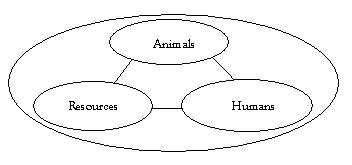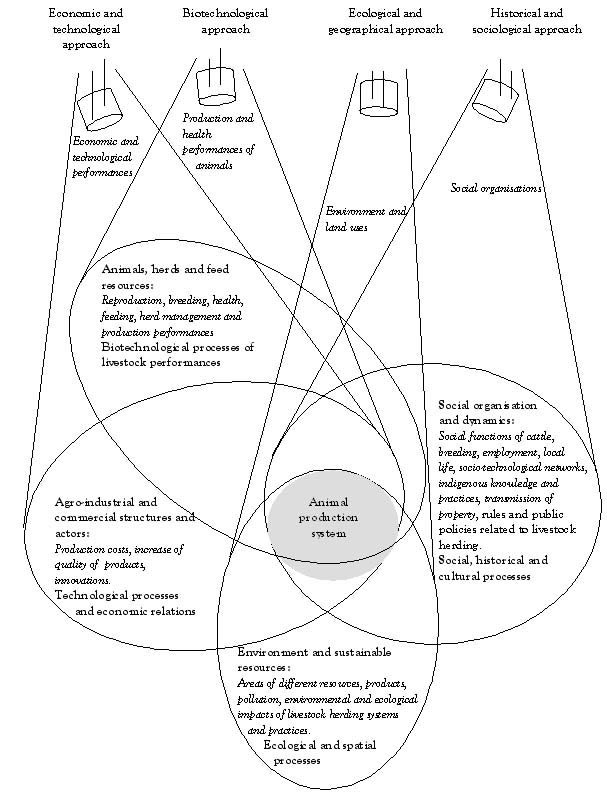C. Jest1 and J. Bonnemaire2
1. Directeur de Recherche (Emeritus), Centre National de la Recherche Scientifique, Paris, France
2. Etablissement National d'Enseignement Supérieur Agronomique de Dijon (ENESAD), Institut National de la Recherche Agronomique (INRA-SAD), Paris, France
The purpose of this yak conference is to explore multidisciplinary aspects and approaches to sustainable yak production on the high altitude rangelands of Central Asia. It is a unique opportunity to recapitulate past efforts concerning yak research and development (R&D), to summarise the accomplishments achieved in the different aspects of research, and to envisage future perspectives. Research and experiments related to yak rearing and pastoralism have only been undertaken recently. In the beginning, these studies were initiated in a few centres, mainly far from the 'field' and often ignoring local practices. We feel it is important to develop a 'global approach' to this research (from a methodological point of view) and to defend the need for more global-oriented research.
There are a number of variables, which relate to the climatic adaptation of yak to their environment. These include: 1) environmental conditions such as temperature, humidity, air circulation, heat, radiation and precipitation; 2) individual characteristics such as species, breed and type; and 3) physical criteria such as productivity, growth, reproduction, physical responses and pathological patterns.
The present approach to yak rearing is, in most of the cases, a 'linear analytical' approach, where each research topic is studied separately. Though each individual topic does require further research, it can also benefit from other lines of enquiry. We would like to present briefly the systemic approach that specialists in cattle rearing have developed in France, which we feel offers useful directions for present and future research related to yak rearing (Landais 1993; Landais and Bonnemaire 1996).
Animal production systems (or livestock herding systems in extensive yak breeding areas) are generally studied in terms of the complex interaction between three components (animals, humans and resources), which are linked by a set of interdependent and interrelated outputs (e.g. animal products, increase of herd, wealth, social position, sustainable land resource management etc.). This systemic approach to herding activities mainly focuses on the relations between the components of the system. This model of the animal production system (Figure 1) can be applied at different organisational levels (e.g. herd, family settlement, social group, ecological or regional area etc.).

Figure 1. Animal production system.
Because livestock herding is fundamentally a human activity which takes place in a specific territory, four complementary approaches need to be taken into consideration when analysing animal production systems: The economic and technological approach, which considers both the subsistence and market economy; the biotechnological approach, which looks at the performances of both individual animals and that of the herd; the ecological and geographical approach, which takes into account the potential of fodder resources, sustainable land use and range management; and the historical and sociological approach, which considers social processes and social organisation. Each of the four complementary approaches mobilises specific disciplinary knowledge and methods, and focuses on some of the multiple relations that link the three components of the system. In other words, each point of view identifies research subjects that, taken together, help us advance our knowledge and understanding of problems related to livestock herding.
We present a graphic representation of an inter- and multi-disciplinary approach to the analysis of livestock herding systems (Figure 2). The figure presents the four major disciplinary approaches as spotlights whose beams converge on the central problem being studied, in this case the animal production system. Just as a camera is focused on an object to obtain a sharp image, the most effective interaction occurs where the four approaches focus their efforts on a specific problem of common concern. Applied to yak rearing, the process involves a number of main issues: e.g. the social organisation of the pastoral community, the indigenous skills and know-how of the people involved, and the technical knowledge needed to upgrade and transmit knowledge.

Adapted from Landais and Bonnemaire (1996).
Figure 2. Four complementary approaches for analysing the animal
production systems.
Before ending, we would like to emphasise the importance of studying yak rearing in marginal zones (by 'marginal zones' we mean the areas on the fringe of the main yak breeding areas, i.e. parts of Mongolia, the ex-Soviet Union states in Central Asia and the Himalayan belt). These zones are of special interest for several reasons. In these 'marginal' areas, diverse categories of animals are bred, such as bovines (Bos taurus, B. indicus and B. grunniens) sheep, goats and horses, as part of a complimentary system of economic production. It also happens that many of these areas have, in recent years, created protected areas such as parks (regional or national parks) and nature reserves. The decision makers in charge of protecting the environment (a concept which was relatively unknown a few years ago by local inhabitants) have taken measures, which, in many cases, have perturbed the life of farmers and pastoralists living in these areas. In addition, in many of these areas, the communities are more and more being exposed to market forces, management systems and outside interventions, which positively or negatively alter the life of the farmers/pastoralists living there. Tourism, often only recently introduced, can also change the ways of life of these communities.
If we may, we would like to emphasise the importance of conducting fundamental research in these areas closely related to a sound sustainable development process. The link between pastoralists, specialists-technicians or scientists in livestock management and animal husbandry, decision makers and actors in the economic and administrative sectors, and the media, should be further encouraged.
As a final remark to this short overview, we would like to re-emphasise the absolute necessity of the circulation of relevant and up-to-date information. If the internet is of help, the more the better, but it is also important to disseminate knowledge through more conventional channels, such as the regular publication of the International Yak Newsletter and the publication of results of experiments both in laboratories and in the field. In this regard, the efforts undertaken by the International Yak Information Centre (IYIC) team are fully acknowledged and further encouraged.
Landais E. (ed). 1993. Pratiques d'élevage extensif. Identifier, modéliser, évaluer. Etudes et Recherches sur les Systèmes Agraires et le Développement, 27. 389 pp.
Landais E. and Bonnemaire J. 1996. La zootechnie art ou science? Entre nature et société, l'histoire exemplaire d'une discipline finalisée. Courrier de l'Environnement de l'INRA, 27 (avril), pp. 23–44.
Bonnemaire J. 1984. Yak. In: Mason I.L. (ed), Evolution of domesticated animals. Longman, London, UK. pp. 39–45.
Bonnemaire J. and Jest C. 1976. Le yak; son rôle dans la vie matérielle et culturelle des éleveurs d'Asie Centrale. Société d'Ethonozootechnie. Ethnozootechnie, 15. Paris, France. 170 pp.
Bonnemaire J. and Jest C. 1993. L'élevage du yak en Asie Centrale. Bulletin d'information sur les ressources génétiques animales, 12. FAO (Food and Agricultural Organization of the United Nations), Rome, Italy. pp. 49–61.
Cai L. and Wiener G. 1995. The yak. FAO (Food and Agricultural Organization of the United Nations) Regional Office for Asia and the Pacific, Bangkok, Thailand. 237 pp.
Editing Committee. 1981. Domestic animals of Xizang. Published in the series of the scientific expedition to the Qinghai-Xizang Plateau. [in Chinese].
Jest C. 1986. Le yak, l'orge et le sel. Une société de montagne en milieu semi-aride himalayen. Technique et culture 7:41–57.
Maoniu kexue Yanjiu Lunwenji. 1990. (Reports on the selection, improvement and utilization of the Chinese yak). Gansu Nationality Publishing House. [in Chinese].
Wu N. 1997. Indigenous knowledge and sustainable approaches for the maintenance of biodiversity in nomadic society: Experiences from eastern Tibetan Plateau. Die Erde 128:67–80.
Zhang Rongchang. 1989. Zhongguode maoniu (le yak en Chine). Lanzhou, Gansu Kexue jishu chubanshe (éditions scientifiques et technologiques du Gansu). [in Chinese].
(We mention here references concerning the Camelidae, as their rearing is in many ways similar to the one of the yak and could lead to useful comparisons. List prepared by M. Tichit INRA-SAD)
Browman D. 1989. Origins and development of Andean pastoralism: An overview of the past 6000 years. In: Juliet C.B. (ed), The walking larder: Patterns of domestication, pastoralism and predation. Uwin Hyman, London, UK. pp. 258–268.
Caro D. 1985. Those who divide us: Resistance and change among pastoral ayllus in Ulla Ulla, Bolivia. PhD thesis. John Hopkins University, Baltimore, Maryland, USA. 357 pp.
Caro D. 1992. The socio-economic and cultural context of Andean pastoralism. Constraints and potential for biological research and interventions. In: Valdivia C. (ed), Sustainable crop–livestock systems for the Bolivian highlands. Proceedings of a SR-CRSP workshop held in University of Missouri, Columbia, USA. pp. 71–92.
Doyen L. and Tichit M. 1999. A viability analysis of mixed herd management in uncertain environments. Cahiers du Centre de Recherche Viabilité-Jeux Contrôle, N° 9906, Université Paris Dauphine, France. pp. 1–25.
Flannery K.V., Marcus J. and Reynolds R. 1989. The flocks of the Wamani: A study of llama herders in the Puna of Ayacucho, Peru. New York Academic Press, New York, USA.
Flores Ochoa. 1979. Pastoralists of the Andes: The alpaca herders of Paratia. Ralph Boulton (trs.), Philadelphia Institute for the Study of Human Issues, Philadelphia, USA. (rare en anglais).
Franklin W.L. 1982. Biology, ecology and relationship to man of the South American camelids. In: Mares M.A. and Genoway H.H. (eds), Mammalian biology in South America. Special publication series, Pymatuning Laboratory of Ecology, University of Pittsburg, Pittsburg, USA. pp. 457–489.
Kuznar L.A. 1990. Economic models, ethnoarchaeology, and early pastoralism in the high sierra of the South Central Andes. PhD thesis. Northwestern University, Evanston, Illinois, USA. 458 pp.
Tichit M. and Genin D. 1997. Factors affecting herd structure in a mixed camelid–sheep pastoral system in the arid Puna of Bolivia. Journal of Arid Environments 36:167–180.
Tichit M. and Genin D. 1999. A viability analysis of mixed herds management. Proceedings of the sixth international rangeland congress, Townsville, Australia, July 1999. Vol. 1, pp. 38–40.
Tomka S.A. 1992. Vicunãs and llamas: Parallels in behavioral ecology and implications for the domestication of Andean camelids. Human Ecology 20(4):407–432.